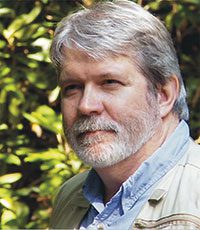By David Ramsey
One cool spring morning in the Smoky Mountains, roughly 30 years ago, I stood thigh-deep in a 4,000-foot-high stream, briefly contemplating my first-ever cast of a dry fly into clear, cold speck water. My heart raced as the size 14 elk hair caddis touched down with nary a sound nor splash and began its short downstream ride toward a waiting and ever-hungry Salvelinus fontinalis. At that moment, all other thoughts and feelings were replaced by the overwhelming anticipation of seeing and feeling the sudden, waterborne strike of orange and green lightning.
A life-affecting connection, at once physical, mental and emotional, was about to be made.
2,000 or even 200 years ago, that connection might have meant I had secured a bit of food for another day of primitive and difficult existence. Today, such singular moments of intense, focused connection with wild living things, in their own wild environments, evoke our primal bonds with the natural world and how we once lived in it. For me, that means the pursuit of wild native trout, in the same places they have inhabited for thousands of years. And I believe the same is typically true for those who pursue large game, small game, waterfowl, upland bird or pretty much any other species we’ve historically depended upon.
But the question on many of our minds these days is whether this vital, inherent bond is being diminished by other aspects of our culture, such as our craving of the quick and the convenient, our vast overconsumption of digital entertainment, social media and politics and, of course, our obsession with business and work. Well, as my teenage granddaughter would say, “Duh!”
Nowadays, relatively few of us truly need to hunt wild animals to sustain ourselves and our families. Of course, there are exceptions among some indigenous and other isolated populations, and there are certainly many people who hunt and fish to supplement their food sources. But the vast majority of us who participate in such outdoor pursuits do it for various reasons, not the least of which is to continue to experience and to sustain that ancient heritage and connection. It’s just that the “us who participate” part is in serious decline.
And here’s the kicker: right on top of this decades-long drop in the number of us who hunt and fish (the recent pandemic-caused spike in such activities notwithstanding) come the massive global problems of climate change and continued overdevelopment, deforestation and exotic species invasions—all of which are contributing to a rapid loss of native species and habitat and, therefore, critically important natural diversity. I know, it’s a bleak and somewhat depressing picture I paint here—but hold on, I promise there’s a positive and very exciting upside to consider.
Question: who better to confront, head-on, and help resolve these serious natural world problems than the people most closely connected to that world? I submit it is the same people I have described here, you and I and millions of others who have long recognized, treasured and strengthened our deep ties to the wild places and things that have sustained us since there first was an “us.” Without our direct, impassioned involvement and connection with those places and things, there simply can never be the kind of wide-scale conservation and preservation now needed to head off the unthinkable.
We absolutely can turn this thing around… if we really want to.
David Arthur Ramsey is an outdoor photographer, writer and conservationist, born and raised in the mountains of northeastern Tennessee. His outdoor writing and photography have been published locally, regionally and nationally and are most often associated with work to preserve and protect threatened lands and waters throughout the Southern Appalachian Mountains.
Field and Stream Magazine and Toyota Motor Company named David the National Hero of Conservation in 2011 for his leadership in saving the 10,000-acre Rocky Fork watershed in northeastern Tennessee. His newly published book, Rocky Fork: Hidden Jewel of the Blue Ridge Wild, tells the story, through his rich photography and his first-hand account, of the more than decade-long battle to preserve this Appalachian and American treasure.
